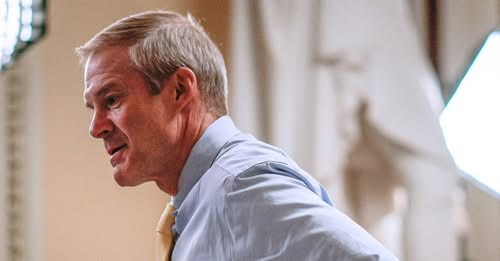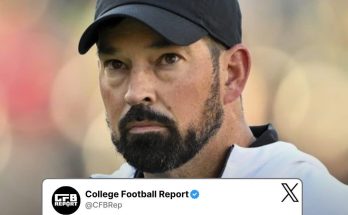The recent legal developments involving Representative Jim Jordan have reignited a firestorm of controversy surrounding the decades-old Ohio State University (OSU) sexual abuse scandal. This scandal, which first entered public consciousness in the late 2010s, centers on the actions of Dr. Richard Strauss, a now-deceased former university physician accused of sexually abusing hundreds of student-athletes under the guise of medical treatment. The investigation into these allegations has already had a far-reaching impact on the reputations and legacies of many involved with OSU’s athletic programs during that time. However, the latest breaking news involves not the original perpetrator, but one of the university’s most prominent former coaches turned high-ranking political figures: Rep. Jim Jordan of Ohio.
Jim Jordan, a founding member of the House Freedom Caucus and a powerful conservative voice in Congress, has long denied having any knowledge of sexual abuse occurring during his tenure as an assistant wrestling coach at OSU from 1987 to 1995. Despite persistent allegations from former wrestlers that Jordan was aware of and possibly failed to act on reports of abuse by Strauss, the Congressman has maintained his innocence and labeled the accusations as politically motivated. Now, however, the news that Jordan will be deposed as part of ongoing legal proceedings marks a significant turning point in the search for accountability and truth.
A deposition, for those unfamiliar, is a sworn out-of-court testimony given by a witness during the discovery phase of a lawsuit. It can be used to gather information and assess the credibility of those involved before trial. In this context, Jordan’s deposition will serve as a critical piece of evidence in lawsuits filed by former OSU athletes who claim that the university—and by extension, officials like Jordan—knew or should have known about Strauss’s actions and failed to protect students from harm. This moment is especially pivotal given Jordan’s status not just as a former coach, but as a sitting member of the U.S. Congress with potential aspirations for higher office.
The implications of Jordan’s deposition go far beyond a personal legal challenge. It reopens a broader societal conversation about institutional accountability, power dynamics in college sports, and how survivors of sexual abuse often face prolonged delays in achieving justice. For years, many of the former OSU athletes who suffered under Strauss felt ignored, shamed, or silenced. Their stories reflect a larger cultural pattern seen in similar scandals, from the Catholic Church to USA Gymnastics, where abusers were shielded by systems that prioritized reputation and revenue over the well-being of individuals.
Several former wrestlers and OSU staff members have gone on record stating that it was common knowledge among athletes and staff that Strauss engaged in inappropriate behavior during medical examinations. Multiple former wrestlers have said they discussed their concerns directly with Jordan or in his presence. Some have described how team members would joke openly about the physician’s “creepy” behavior, implying a shared understanding that something was not right. To many of these men, the idea that Jordan was unaware strains credulity.
Jordan, for his part, has repeatedly denied any knowledge of the abuse, claiming that if he had been aware, he would have taken immediate action. His defenders argue that the accusations are politically motivated attempts to discredit a powerful conservative figure. They point out that no documentation has emerged directly tying Jordan to a cover-up, and that memory, especially from decades ago, can be unreliable. Critics counter that the number and consistency of the allegations suggest a pattern that should not be dismissed as mere coincidence or partisan sabotage.
The legal landscape surrounding the OSU scandal is complex. The university has already conducted an independent investigation led by the law firm Perkins Coie, which concluded that Strauss abused at least 177 male students over two decades and that university officials failed to act on repeated warnings. The report did not find direct evidence implicating Jordan but noted that numerous staff members were aware of complaints. Lawsuits from former athletes against the university continue to work their way through the courts, and Jordan’s deposition may bring new facts to light that could influence those cases.
For the survivors, Jordan’s deposition represents more than just another procedural step—it symbolizes a potential moment of reckoning. Many have long felt that those in positions of authority at OSU, including coaching staff, administrators, and trustees, failed them miserably. The process of deposing Jordan may be emotionally fraught, particularly if he continues to deny any knowledge of the abuse. Yet for survivors, there may be some solace in seeing powerful individuals held to account, even if only symbolically.
The fact that this development involves a sitting member of Congress further elevates its significance. Members of the public may find it troubling that someone potentially connected to such a scandal holds immense legislative power and influences national policy. On the other hand, some may view the deposition as proof that even the powerful are not immune from scrutiny and that the legal system can still serve as a tool for justice, however belated.
It’s also worth reflecting on the broader ethical obligations of coaches and authority figures in college athletics. A coach is more than just a strategist or trainer—they are mentors, protectors, and sometimes the closest adult figure in a young athlete’s life. When signs of abuse emerge, the ethical responsibility to act should be clear and unambiguous. Even if Jordan’s defenders argue that he didn’t know, critics contend that he should have known. After all, the culture around OSU wrestling reportedly included jokes and casual acknowledgments about Strauss’s behavior. In such an environment, feigned ignorance or inaction becomes harder to justify.
The OSU case also adds to the growing body of evidence that institutions often prioritize their own reputations over the safety of the people they serve. This phenomenon is by no means unique to Ohio State. The scandals at Penn State, Michigan State, and the University of Southern California demonstrate a recurring theme: powerful institutions with deep ties to money, sports, and prestige frequently fail to act swiftly or transparently when allegations of abuse arise. These failures often compound the trauma experienced by survivors, who must not only live with what happened to them but also endure years—sometimes decades—of denial, dismissal, and legal obstruction.
As Jordan prepares to testify, there will be inevitable political ramifications. His opponents will likely use the deposition as ammunition, casting him as part of a broader culture of complicity and moral cowardice. His supporters may double down, framing the legal scrutiny as a witch hunt designed to derail his political ascent. It is important for observers to approach these events with a commitment to truth and justice, rather than falling into partisan tribalism. What is at stake here is not just Jordan’s career, but the broader question of how society treats allegations of sexual abuse—especially when they implicate the powerful.
The legal process will also be a test of how seriously our institutions take survivor testimony. In an era where the #MeToo movement has elevated the voices of the abused, the OSU scandal serves as a reminder that accountability often comes too late and only after immense pressure from the public and the media. Survivors in this case have waited years for acknowledgment, and some may never see the kind of justice they deserve. Nevertheless, each deposition, each courtroom testimony, and each piece of new evidence brings us closer to a full reckoning.
Furthermore, Jordan’s deposition could influence other lawsuits or even spark new ones. If new information comes to light suggesting negligence or complicity, it could lead to additional legal scrutiny of other OSU staff members or administrators. It could also push lawmakers to reconsider how statutes of limitation affect survivors’ ability to seek justice years after abuse occurs. In some states, the legal window for filing such cases has been expanded or eliminated altogether—a trend that advocates say is long overdue.
There is also a human dimension that should not be lost amid the legal jargon and political speculation. The men who were abused by Dr. Strauss were often teenagers or young adults, just beginning their lives and careers. Many have spoken about the long-term psychological toll the abuse took on them—struggles with trust, intimacy, anxiety, depression, and even substance abuse. Some have described how the betrayal by adults they trusted was more damaging than the abuse itself. These stories deserve empathy and attention, not just as cautionary tales, but as urgent calls to improve the safeguards within all institutions that serve young people.
The OSU case should also compel athletic departments nationwide to reevaluate their internal reporting mechanisms and oversight structures. How easy is it for an athlete to report abuse? Will they be believed? Are there independent channels for lodging complaints that don’t involve the same coaches and administrators who might be implicated? These are not abstract questions—they are essential to preventing future abuse and ensuring that universities remain safe spaces for learning and growth.
As this story continues to unfold, it’s important to keep the focus where it belongs: on the survivors who had the courage to come forward. Their persistence has already forced one of America’s most prominent public universities to reckon with its past. Their testimony may now compel a powerful Congressman to answer uncomfortable questions under oath. And their bravery serves as a powerful reminder that no institution—be it a university or the U.S. Congress—should ever be immune from accountability.
In the months ahead, Jim Jordan’s deposition will likely be just one chapter in a longer legal saga. But it is a chapter worth paying close attention to, not only for what it might reveal about the past but for what it could mean for the future of institutional integrity, survivor advocacy, and the role of public figures in our democratic society. Whether it leads to new revelations, policy changes, or simply a greater public understanding of the challenges abuse survivors face, it marks a critical step in a journey that has already reshaped lives and shaken long-standing power structures. In the pursuit of justice, every voice matters—and every truth told brings us one step closer to the kind of accountability survivors of abuse so deeply deserve.



